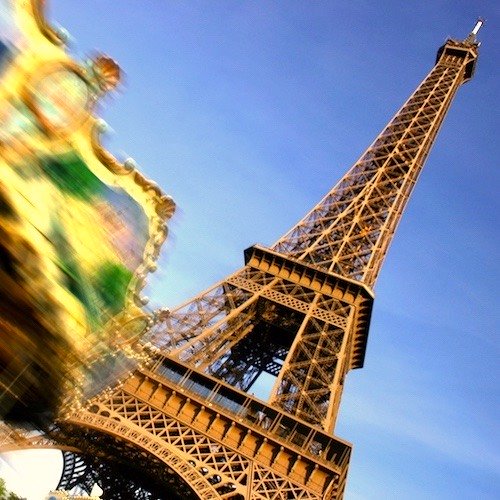Where the West Begins – Gare Montparnasse, Paris Train Station
In a city of grand arrivals, Gare Montparnasse Paris makes a bold statement. This Left Bank station is anything but quaint — it's big, busy, unapologetically modern, and deeply woven into the capital's railway history. It's where the TGVs roar westward toward Brittany and beyond, and where layers of 20th-century ambition meet 21st-century reinvention.
The Montparnasse Train Station is more than a stop along the way. It's a destination in its own right, with rooftop gardens, avant-garde murals, and a palpable sense of Parisian efficiency. If your travels begin or end here, you're in solid company.
History & Evolution
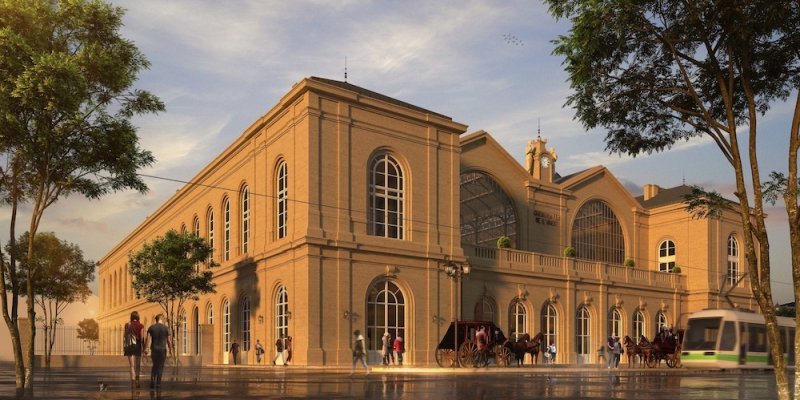 Gare Montparnasse Paris as it looked in 1852, with some modern touches, art by Adeel Hameed
Gare Montparnasse Paris as it looked in 1852, with some modern touches, art by Adeel Hameed
The original Paris Montparnasse Station opened in 1840, back when steam was cutting-edge and the idea of zipping across France in under two hours would've sounded like science fiction. But the current version of the station, shifted a few hundred meters and completely rebuilt in 1969, is a different beast altogether — larger, bustling, and built for the high-speed age.
One of its most enduring stories? A runaway train in 1895 that careened through the station wall and crashed onto the street below. It's the kind of accident that seems impossible now but lives on as one of the most famous photos in railway history. If you've ever seen a steam engine hanging nose-first out of a building, that's Montparnasse's claim to fame.
During WWII, the old Gare Montparnasse played an unexpected role in the Liberation of Paris when German general Von Choltitz surrendered there in 1944. That alone gives the station more gravitas than its glass-and-steel exterior lets on.
Architecture & Artistic Touches
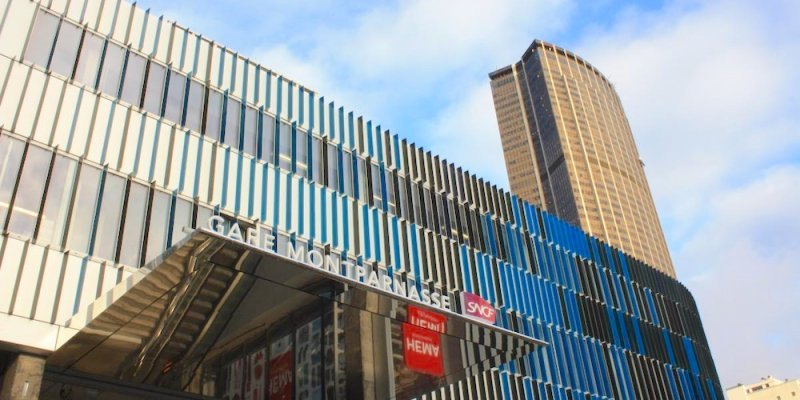 The exterior of Gare Montparnasse Paris after its renovation, photo by AREP
The exterior of Gare Montparnasse Paris after its renovation, photo by AREP
Montparnasse Train Station doesn't exactly charm you with Belle Époque frills. It goes for concrete strength and open-scale ambition. But what it lacks in decorative whimsy, it makes up for in scale, substance, and some unexpected visual flair.
Take the Jardin Atlantique — an entire public park floating high above the tracks on the rooftop, where pine trees, modern sculptures, and an air of suburban calm sit atop a high-speed transport hub. It's the kind of urban oddity that feels surprisingly Parisian.
Inside the Paris Montparnasse Station itself, a sprawling mural by Victor Vasarely injects life into otherwise functional architecture. The artist's famous optical illusions sprawl across the walls, making waiting for a train feel like stepping into a mid-century dream sequence.
Between 2017 and 2021, Gare Montparnasse Paris got a much-needed facelift — less cosmetic touch-up, more full structural rethink. Out went the dim concrete walkways; in came a luminous glass-and-steel footbridge that made the Vasarely Hall feel less bunker, more atrium. The overhaul didn't stop at circulation — retail spaces were expanded, new shops and restaurants moved in, and the whole place finally started feeling like it was built for the number of people who actually use it. It's still a labyrinth, but now it's a shinier, brighter, better-fed one.
Cities Served by Gare Montparnasse Paris
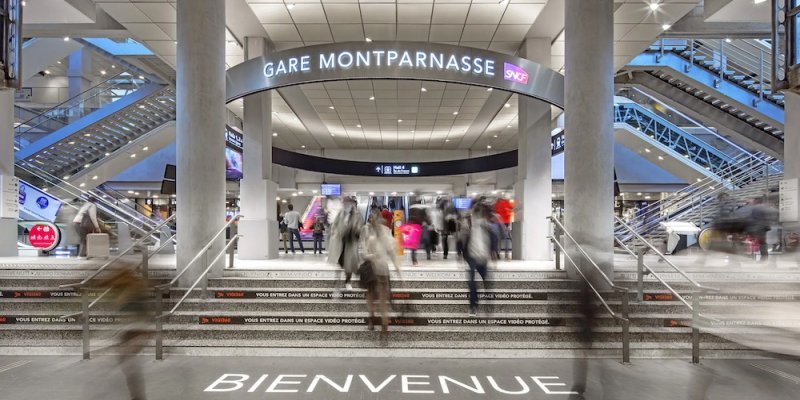 Interior entrance of Gare Montparnasse Paris post-renovation, photo L'Observatoire
Interior entrance of Gare Montparnasse Paris post-renovation, photo L'Observatoire
The Gare Montparnasse Paris train station station acts like a slingshot aimed at western and southwestern France. The TGV Atlantique lines serve up high-speed routes that make serious ground in no time — Rennes in under two hours, Bordeaux in just over that, and countless other cities that stretch all the way to the Atlantic.
Looking for a seaside holiday? Trains from Montparnasse glide into La Rochelle, Arcachon, Hendaye, and Saint-Jean-de-Luz. For cultural weekenders, there's Nantes with its mechanical elephant, or Tours with its chateaux-heavy countryside. Even obscure corners of Brittany — think Quimper or Brest — are suddenly within reach.
The Montparnasse Train Station also serves Angers, Le Mans, and Poitiers, linking regional centers into the national fold. The station's rail reach is vast — at once practical and strangely poetic. You board surrounded by commuters, and disembark where oyster shacks line the coast.
International travelers often overlook Gare Montparnasse Paris in favor of Gare du Nord orGare de Lyon, but this is the station that leads to windswept beaches, vineyard towns, and sun-drenched summer markets. In terms of sheer geographic reach, Montparnasse does its job quietly, effectively, and with the occasional scenic flourish.
Train options include TGVs, Intercités, and TER services. If you're lucky, you might snag a seat on an OUIGO — France's low-cost, no-frills bullet train. Think of it as the discount airline of the rails, minus the turbulence and with better sandwiches.
Gare Montparnasse Paris doesn't stop at the border of Paris. It's a launchpad, pushing people out of the capital and into the rest of the country — fast, direct, and with just enough Parisian flair to keep things interesting.
Shopping & Dining: A Compact Commercial Jungle
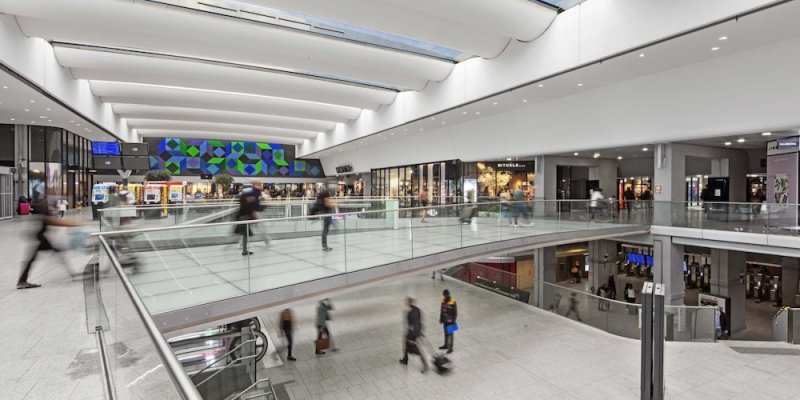 A shopping plaza at the renovated Gare Montparnasse Paris, photo Jouin-Maku
A shopping plaza at the renovated Gare Montparnasse Paris, photo Jouin-Maku
Gare Montparnasse Paris doesn't do anything halfway, including retail. The shops here range from practical (luggage and pharmacies) to "I didn't know I needed this" territory. You'll find Sephora, L'Occitane, Levi's, Marks & Spencer Food, and FNAC all squeezed into the station's multiple halls.
It's also a surprisingly satisfying spot to grab a bite. Sure, you'll find chain cafes, but there's also a rotating cast of brasseries, bakeries, and patisseries run by names like Pierre Hermé and even Alain Ducasse. The guy has Michelin stars to spare and still finds time to elevate station fare.
With new retail developments constantly unfolding, Montparnasse isn't done growing. Future plans hint at even more shopping and dining, possibly turning the station into a legitimate destination — even for people who aren't catching a train.
Nearby Attractions Worth a Detour
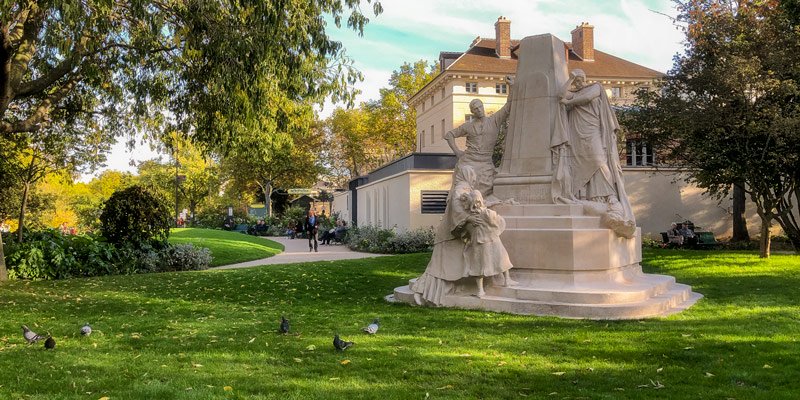 The garden of the Museum of the Liberation of Paris, photo by Mark Craft
The garden of the Museum of the Liberation of Paris, photo by Mark Craft
If you've got time before departure — or you're simply curious about what the area has to offer — stick around. The neighborhood around Gare Montparnasse Paris punches above its weight when it comes to attractions.
First up: Tour Montparnasse. Love it or loathe it, this glassy monolith offers some of the best views of Paris, precisely because it's the only place where you won't see the tower itself in your photos.
Just a short walk away lies the Montparnasse Cemetery, where you can pay your respects to the likes of Simone de Beauvoir, Jean-Paul Sartre, and Samuel Beckett. Quiet, leafy, and wonderfully under-visited.
And if the station's wartime history piqued your interest, the Museum of the Liberation of Paris is nearby and well worth a detour. Hidden inside former command bunkers, it offers a moving and well-designed look at Paris during the Occupation and Liberation.
Tips for Navigating Paris Montparnasse Station
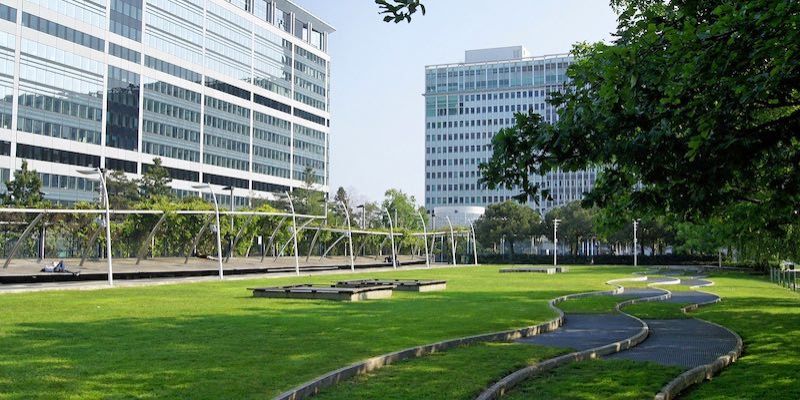 Jardin Atlantique on the roof of Gare Montparnasse Paris, photo Wikimedia by besoopha
Jardin Atlantique on the roof of Gare Montparnasse Paris, photo Wikimedia by besoopha
This station is a labyrinth, no use sugar-coating it. Gare Montparnasse Paris has multiple levels, four departure halls (1 to 4), and a swarm of escalators and signage that make orientation feel like a mini quest. Hall 1 and 2 serve most TGVs, while Hall 3 handles regional trains. Hall 4, also known as "Vaugirard," sits off to the side — don't assume it's just around the corner.
Metro lines 4, 6, 12, and 13 all pass through the connected Montparnasse-Bienvenue station, but don't expect a quick dash between lines — these transfers involve long corridors and plenty of walking.
A Few Tips from the Paris Insiders Playbook
- Arrive early. Really early.
- Don't skip the Jardin Atlantique. Even 10 minutes of fresh air can improve any journey.
- Accessibility services are reliable, but not immediate — best to arrange assistance ahead of time if needed.
- Lockers and left-luggage services are available but fill up fast during busy travel periods.
- And if you're hungry, thirsty, or just plain cranky, don't settle for the first snack stand you see — some of the better options are hidden a level up or down.
Connections & Commuting
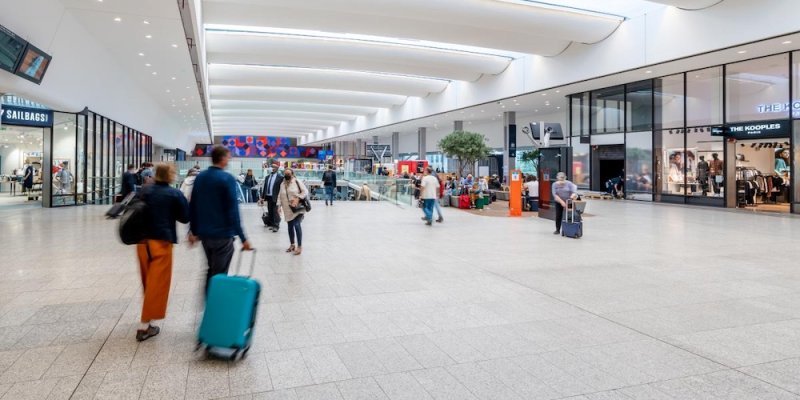 Travelers inside the renovated Gare Montparnasse Paris, photo AREP
Travelers inside the renovated Gare Montparnasse Paris, photo AREP
Gare Montparnasse Paris isn't just for long-haul trips. It's a local commuter's lifeline, a Paris Metro web node, and a surprisingly useful link to both Orly and Charles de Gaulle airports.
Let's start underground. The Paris Montparnasse Station connects to four metro lines: 4, 6, 12, and 13. That's a generous spread, offering direct access to spots as far apart as Pigalle and Place d'Italie. Just be warned: the Montparnasse-Bienvenue metro station is sprawling. A change of lines can easily mean five to ten minutes of determined walking.
Above ground, the bus game is strong. Dozens of RATP buses call here, including several that run along Boulevard du Montparnasse and into central Paris. If you're heading south, Orly is a relatively quick ride away. You can take the OrlyBus or link via metro and tram depending on your level of luggage-induced optimism.
For Charles de Gaulle Airport, it's not quite a straight shot, but doable via RER B from Denfert-Rochereau or by shuttle services. Still, unless you've got an unshakable fondness for train changes, CDG is often better approached from Gare du Nord.
Taxi ranks are located on Place Raoul Dautry, just outside the main entrance. Ride-share apps work fine, though pickups can be a bit chaotic at peak hours. This is, after all, one of the busiest transport hubs in the city. A little patience — and maybe a croissant — goes a long way.
As Paris stations go, Montparnasse isn't the easiest to navigate — but it's one of the most connected, and the learning curve flattens fast once you've walked the labyrinth a few times.
Paris Planning Guides
 Book an Airport Transfer
Book an Airport Transfer |
 Left Bank Hotels
Left Bank Hotels |
 10 Food Experiences
10 Food Experiences |
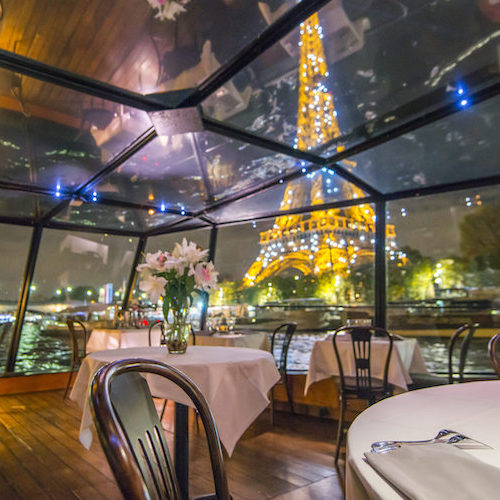 Glorious Dinner Cruises
Glorious Dinner Cruises |



